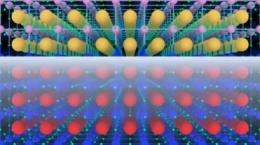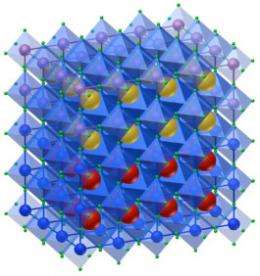The interface between two non-conductive materials can be conductive

How can an electrically conductive interface appear at the junction between two materials which do not conduct electricity? Since such a phenomenon was discovered in 2004, conflicting hypotheses have been put forward in order to respond to this question, each with its fervent supporters and critics. An international team bringing together researchers from the Paul Scherrer Institute (PSI), the University of Geneva (UNIGE) and the University of Liege’s Department of the Theoretical Physics of Materials have clarified the debate.
These researchers have shown that the conductivity results from an effect intrinsic to the junction between the two materials, refuting the alternative hypothesis of an extrinsic origin connected to the presence of imperfections introduced during the junction being developed. The interface between these two compounds possesses fascinating electrical and magnetic properties which offer a glimpse of a certain number of applications in the areas of electronics and computer science. The results have been published in the journal Nature Communications.
In 2004 researchers discovered a conductive layer at the interface between two insulating oxides, SrTiO3 and LaAlO3. After several years of intensive research, the origins of the conductivity still remain controversial.
One school of thought links this conduction to properties intrinsic to the junction. In simplistic terms, the different chemical nature of the atoms which make up SrTiO3 and LaAlO3 is thought to be responsible for an imbalance in the electrical charge on one part or another of the interface. To compensate for this imbalance the theory predicts that for a critical thickness of LaAlO3, the electronic system will rearrange itself by transferring electrons to the interface, thus rendering it conductive.

This explanation, which goes by the name of the ‘polar-catastrophe model’, sets its face against the idea that imperfections, inherent to the growth of the layer of LaAlO3, is at the root of a chemical doping of the region of the interface and generate the conductive layer.
The appropriate experiment
In order to clarify this controversy, the team of researchers came up with an experiment allowing a fundamental prediction of ‘polar-catastrophe’ to be tested in order to validate this explanation.
The experiment consisted of replacing one of the materials, LaAlO3, by its alloyage with the other compound, thus modifying the charge imbalance at the interface. At the University of Liege, Denis Fontaine and Philippe Ghosez theoretically predicted the effect of this change on the critical thickness. The PSI and UNIGE groups produced samples and measured them. These experiments showed that the relationship between the critical thickness and the composition of the alloy perfectly matched the theoretical prediction, demonstrating the phenomenon’s intrinsic origins.
Numerous applications in sight
This conductive interface could play an important role in future applications such as those of transistors or sensors. The fact that the origins of the conductivity are intrinsic to the system is a plus for the development of oxide based electronics.
More information: Tunable conductivity threshold at polar oxide interfaces, Nature Communications, doi: 10.1038/ncomms1936
Journal information: Nature Communications
Provided by University de Liege


















